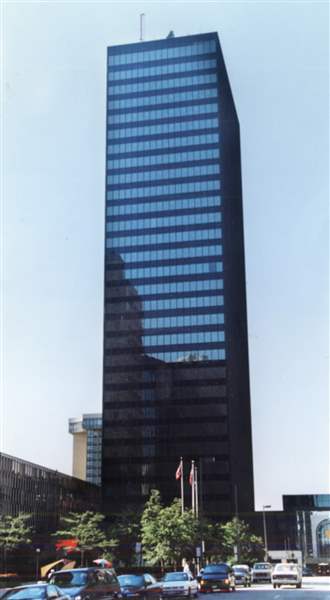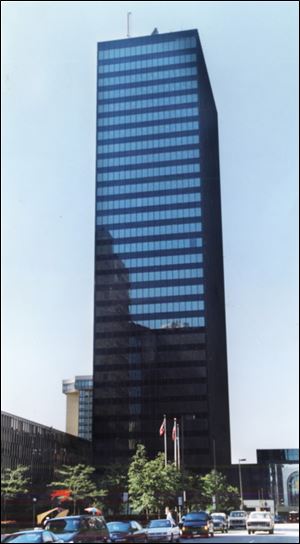
REVITALIZING TOLEDO
ProMedica another victory for downtown
$40M plan caps years of restoring city’s core
2/9/2014
A Michigan firm that owns the Fiberglas Tower has presented multiple plans and sought taxpayer support but struggled to close a deal that would renovate the building.
THE BLADE
Buy This Image

A Michigan firm that owns the Fiberglas Tower has presented multiple plans and sought taxpayer support but struggled to close a deal that would renovate the building.
Twenty years ago there was no Huntington Center, no Fifth Third Field, no Valentine Theatre, no La Salle Apartments, no Commodore Perry Apartments.
Downtown had a fraction of the public and private investment in the area today.
The adjacent Warehouse District two decades ago was a cluster of empty buildings — no trendy coffee shop, bars, and restaurants, no candle shop, no art galleries that exist now.
Government offices always had a place downtown, but titans of Toledo’s manufacturing and glass industry fled to the suburbs, such as when Owens-Illinois Inc. moved to Perrysburg.
Twenty years ago, downtown was home to an adult book store and Brenda’s Body Shop along Monroe Street where prostitutes occasionally roamed the sidewalks.
But since then Toledo, Lucas County, and state officials have pumped tens of millions of taxpayer dollars into developments such as Fifth Third Field and Huntington Center. Two historic buildings were converted into market-rate apartments, and taxpayers footed the $43 million bill to clean up 125 acres on the other side of the Maumee River in the Marina District.
ProMedica’s announcement last week that it had selected the downtown former Toledo Edison Steam Plant and KeyBank Building as its new corporate headquarters — where 700 employees will be consolidated in one campuslike riverfront setting — is evidence to many that the public investment to remake downtown is paying off.
Randy Oostra, ProMedica president and chief executive officer, told The Blade the company’s purchase and renovation of the Steam Plant could cost up to $40 million and begin in 2016. The move to a new campus created with the two buildings along the Maumee River — which would include consolidating employees from the health system’s Richards Road corporate headquarters, office space elsewhere in Toledo, and from some locations outside the city limits — would be the largest influx of jobs downtown in decades.
Joe Napoli, president and general manager of the Mud Hens and Walleye, said the public and private investments into the downtown area and the risks investors took are beginning to yield positive results.
“I do believe we are at the tipping point. People who live downtown enjoy living downtown,” he said. “This may sound like an exaggeration, but I see the reaction to ProMedica akin to the buzz that was created when we announced the ballpark would be built downtown. It is a pride thing. That is a hard thing to measure.”
A revival
The downtown revival began more than a decade ago with Fifth Third Field, continued with the construction of Huntington Center and the renovation of historic landmarks such as the Commodore Perry and Standart Lofts, and will be bolstered with revitalization projects for other old structures, including the Berdan Building and the cluster of vacant buildings near the baseball stadium.
In recent years, a number of high-profile developments have moved forward.
The Mud Hens went public last summer with plans for the $21 million revitalization project of vacant buildings on South St. Clair Street to create an entertainment district to be called “Hensville.”
Mr. Napoli said the organization is in the stages of applying for federal, state, and new market tax credits and to break ground late this year or early 2015.
“When we are done with Hensville we will have a solid blueprint on using new market tax credits and historic tax credits, state capital funds, and the Mud Hens own funding that can be used and shared for other renovations and rehabilitation of buildings in the downtown area,” he said.
Developers and business owners praised the ProMedica decision.
“I think the announcement by ProMedica has been overwhelmingly positive. I think it really has taken quite a few people by surprise on how positive the reaction has been,” said Mr. Napoli, who is a member of Toledo Children’s Hospital board of directors.
Paul Sullivan, an architect, Warehouse District resident, and advocate for downtown historical preservation, agreed that the future ProMedica headquarters is adding to momentum in redevelopment in the downtown business core and nearby districts.
“I think it is a sign of very good things to come in downtown Toledo,” Mr. Sullivan said.
Fiberglas Tower
An East Lansing, Mich., firm that owns and wants to redevelop the Fiberglas Tower downtown has presented multiple plans and asked for taxpayer support several times but struggled to close a deal that would renovate the 33-story building.
Nick Eyde, a partner of Eyde Co., said the company, which has owned the Fiberglas Tower since 1998, said the ProMedica move could be the added push needed to repurpose the former Owens Corning headquarters building.
“We are thrilled about it ... because the more critical mass downtown, the more downtown Toledo grows,” Mr. Eyde said. “We put $1.7 million into [the building’s] parking structure and that turned out very nicely, and the asbestos abatement has been completed so we are ready.
Two years ago, the company was seeking historic tax credits worth up to 25 percent of the project cost but not exceeding $5 million as part of a financing plan to turn the vacant building into a mixed-use facility.
The total cost of renovating the renamed “Tower on the Maumee” to include office space, a hotel, a retail area, and apartments was at that time estimated to be $29.4 million.
The plan then included a 96-room Courtyard by Marriott in the building. Mr. Eyde said he is negotiating with potential tenants whom he declined to identify.
Forward progress
As the owner of the baseball stadium, the arena, and parking facilities, Lucas County has been responsible for more than $200 million in taxpayer dollars in downtown investments, with most of that in the downtown core, Commissioner Pete Gerken said.
“We, as the largest property owner with the greatest number in dollars invested in the downtown over the last decade, see ProMedica as very good news. We are ecstatic that ProMedica saw the value we have seen for years in the value of reinvesting for creating a strong downtown and one that harkens back to the 1960s,” Mr. Gerken said. “It validates what the county has been saying all along; if you prime the pump and put things downtown that people want to create a place and other people will join you.”
Developer Kevin Prater, who along with partner Richard Karp, purchased the vacant Berdan Building in the Warehouse District last year and announced a $30 million plan to renovate it into living and retail space, also praised the planned ProMedica move downtown.
“It’s going to keep the momentum and the rebirth of downtown Toledo continuing,” Mr. Prater said.
The Lansing developers who renovated the nearby Standart Lofts, a 75-unit apartment building, bought the Berdan Building for $700,000.
He said downtown Toledo experienced a lull in development after the Huntington Center and Standart Lofts were completed but thinks ProMedica’s move would reinvigorate other development.
Parking needs
Tim Grohnke, vice president of real estate and construction for ProMedica, said the company considered multiple locations — none of which he would identify.
“There are not a whole lot of facilities downtown that could accommodate that many people ... and parking is still a very big issue for us to solve,” Mr. Grohnke said. “We hope to be a catalyst for downtown and we don’t want to impede that by taking up the spaces that are there.”
Mr. Oostra said an underground parking structure is envisioned in the expanded portion of Promenade Park, adjacent to Summit Street on the site of the former downtown Federal Building. He said the garage would be landscaped to blend in with the riverfront park and provide parking for people coming downtown for riverfront entertainment and festivals.
He said one concept being considered would have a single level of parking above ground, which would open out to the river and be fronted with retail shops.
Mr. Oostra also said ProMedica asked for nothing from the city or the state as a condition and stressed that the planned move is not a concept; he intends for it to happen.
Mr. Napoli said he sympathizes with ProMedica’s concerns with parking to accommodate the hospital system’s long-term needs. He said the Mud Hens put a lot of thought into parking as they contemplated the move into the Warehouse District and the impact the stadium would have on other businesses.
“I think it just indicates how smart the folks at ProMedica are to want to take this issue off the plate,” he said. “When we moved downtown we wanted to have safe, secure parking for the long term, and, I think that is why it is very important to them to take a look at that question and put it to rest forever.”
Contact Ignazio Messina at: imessina@theblade.com or 419-724-6171 or on Twitter @IgnazioMessina.